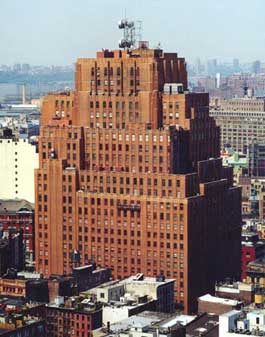The Most Important Building in New York
The terrorists who flew planes into the World Trade Center on September 11th, 2001, may have missed an opportunity to deliver a serious blow to capitalism as well as killing thousands of innocent people. Situated just a few hundred yards from the Twin Towers sits an art-deco, red-brick building which houses the network infrastructure equipment for international communications and the New York Stock Exchange (NYSE).
Known as a "Carrier Hotel", because it offers rented floorspace to network carriers, 60 Hudson Street is important because it is a primary "meet-me" location for over 100 comms providers to exchange signals. In an article from 5 days before the attacks, the author chillingly identifies the building as "Ground Zero" for international telecommunications.
Lets Play the Postulation Game
So what would have happened if Al Qaeda had smashed a plane into "60 Hudson"?
It doens't take a genius to realise you'd find one major hub in the transatlantic communications network would be severed. But that is a mostly intangible effect. Nobody would be rushing to the emergency room complaining of a lack of an Internet connection. And anyway, there are satellites to work around problems like that.
What is really scary is what else is in the building besides 70 million feet of cables and 30 miles of conduit.
The building has such a huge reliance on electrical power (it houses a 10kV DC power plant inside it) that it contains a vast amount of fuel oil to power the generators. The New York Times says that 80,000 gallons of fuel oil is stored in the building.
Lawyers have already stated that if a fire broke out in the building, this stored fuel would pose a huge risk to nearby housing and schools. Combine this with the 60,000lbs of fuel a Boeing 767 would have on board for a cross-country flight and you end up with a double whammy for communications and casualties.
Thirteen-point-three Milliseconds
It's vital that you don't underestimate the importance of 60 Hudson. Trades of stocks and shares that go through here (from London, LA, Hong Kong, etc.) are so important that vast amounts of effort and money goes into keeping the data flowing in and flowing out at incredible speeds.
It is 825 miles to Chicago from this particular Carrier Hotel. To improve the latency (the delay between signals leaving one point and arriving at another) a trench has been dug all of those 825 miles to gain an extra 3 microseconds on the existing fastest route. Consider it takes 25 milliseconds to blink, the round trip along 825 miles is 13.3 milliseconds. 3 microseconds is only a matter of feet, and yet, it could make or break enormous deals.
Kevin Slavin talks more about this in his TED Global 2011 talk:
Imagine how much money it costs to build an 825 mile trench and pack it with fibre-optic cables... For 3 microseconds!
This is undoubtedly the most important building in New York City, but it might also just be the start. Kevin says that if we're happy to dig a trench that's longer then the British Isles are tall for the sake of a 3 microsecond jump on the competition, then we may end up terraforming the oceans just to plant server farms 50% closer to the deals that are being made.
The Mid-Atlantic Holiday Hub
In a recent daydream, I considered the problem that trans-atlantic aircraft journeys have. These aircraft must obey strict reliability and procedural rules called ETOPS - Extended Range Operations. This means that they can fly up to 3 hours away from a suitable airport, even if they have only two engines, in order to make the most direct routing.
ETOPS means that most aircraft take a slightly more northerly route than the most direct one because this keeps them as close as the rules dictate to suitable airports like Gander in Newfoundland, or Keflavik in Iceland.
If we are going to spend all this money building platforms in the Atlantic to intercept financial information sooner than the eventual recipients 50% of the Ocean away, it doesn't seem too outlandish that the platform could be used for another benefit: a Mid-Atlantic Emergency Airport.
With a nice big runway to allow it to operate as an ETOPS-approved airport, it would also allow transatlantic air traffic to take more direct routes.
But why stop there?
Extend it further into a luxurious holiday resort that uses oil-rig technologies to keep it steady even in rough seas (the Atlantic Ocean is about 4 miles deep in the middle, so the resort would have to "float"), and you have a unique holiday offering that is a mere 4 hours flight from most of Western Europe and even less than that from the Eastern Seaboard of the US.
This idea has legs I tells ya!

Comments...